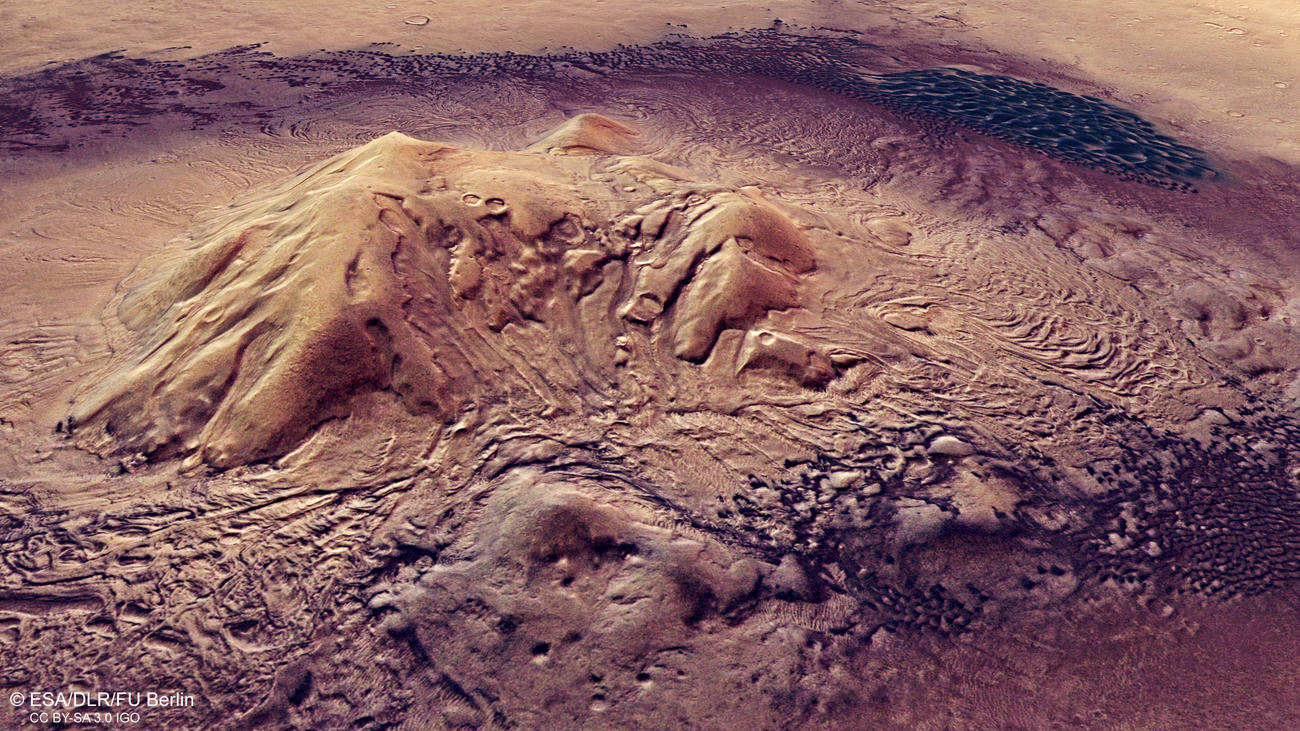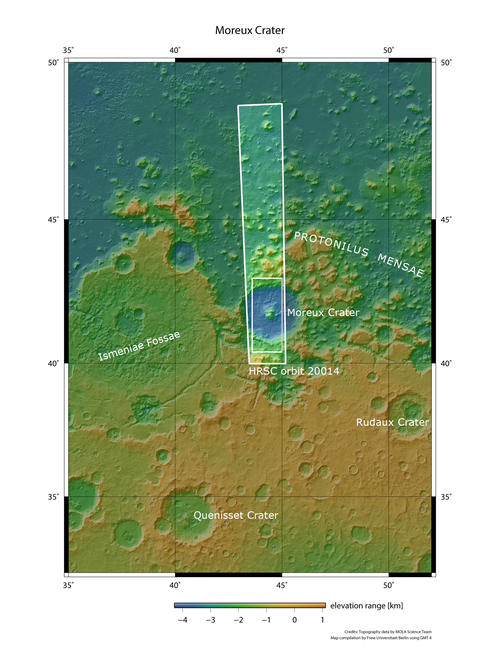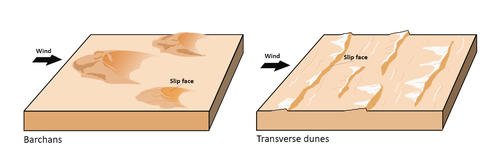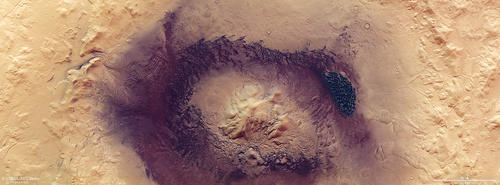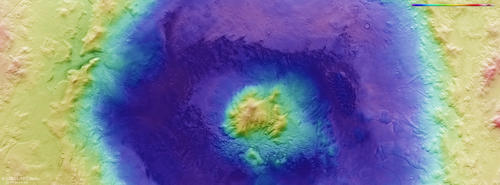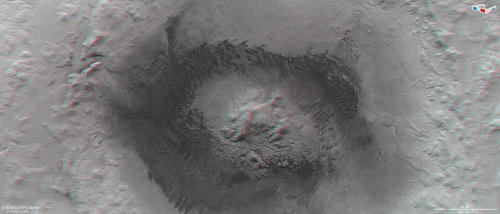Department of Earth Sciences
Service Navigation
Mars crater Moreux and its dark dunes
These images of the High Resolution Stereo Camera (HRSC) on board ESA’s Mars Express mission show the prominent impact crater Moreux at the dichotomy boundary on Mars. The floor of Moreux Crater is extensively covered by dark dunes, which are abundant on Mars. HRSC is a camera experiment that was developed and is operated by the German Aerospace Center (Deutsches Zentrum für Luft- und Raumfahrt; DLR).
» read more in the main article and below the gallery about Mars Crater Moreux ...
Moreux Crater • Location and Scheme
context map
Image Credit: MOLA Science Team/FU Berlin
Moreux Crater • Images
HRSC color image
Image Credit: ESA/DLR/FU Berlin
HRSC color-coded terrain model
Image Credit: ESA/DLR/FU Berlin
HRSC anaglyph
Image Credit: ESA/DLR/FU Berlin
Mars crater Moreux and its dark dunes
» read more about the Moreux Crater on Mars
The Moreux Crater on Mars has a diameter of 135 kilometers and a depth of three kilometers measured from the rim. It is located in the Protonilus region at the Martian highland-lowland boundary. The rim and floor of Moreux Crater have undergone substantial glacial modification within the last millions of years. Lobate flow features of ice-rich debris around the central peak and in the southern part of the crater point to recent and episodic glacial activity.
Ice-rich material has left behind a diverse glacial treasure trove, which can be found mainly around the central peak and along the crater rim. This includes numerous valleys that carve into the flanks. Polygonal structures at the bottom of these valleys have been interpreted as patterned ground, or periglacial landforms. Linear valley fillings, such as in the wide valley at the southern crater rim, were created by the meeting of ice and scree masses that once slid down the valley slopes and met in the middle of the valley. Tongue-shaped deposits and viscous flow patterns are remnants of rock glaciers that formed almost everywhere along the crater wall.
Dating of these terrain forms has revealed that glacial and periglacial processes occurred here repeatedly during a period that lasted from approximately one billion to 400,000 years ago. Moreux Crater is situated at 41.6 degrees north, in the mid-latitudes of Mars, where glaciation processes occurred mainly when the axis of rotation of Mars was tilted at a greater angle than it is today (currently the inclination is 25.2 degrees) and the poles, with their ice caps, were tilted more directly towards to the Sun. Then, at mid-latitudes, more ice and snow from the atmosphere was deposited on crater edges and plateaus, where it collected and formed glaciers.
The two-kilometre-high central peak in the crater is surrounded by dark, sandy material. Winds have piled it up into groups of individual dunes and also into contiguous dune fields. The grey-black dunes (they only appear bluish in these contrast-enhanced colour images) consist of volcanic sand and fine ash with a basalt composition. This is mainly comprised of the minerals olivine and pyroxene, which cause the dark colouring of basaltic materials. Both minerals are silicates and have a high content of magnesium and iron.
The dune fields in Moreux Crater show slight colour variations, possibly caused by differences in the composition of the dunes. The OMEGA spectrometer on Mars Express can be used to investigate the mineralogical composition of surface materials. The large contiguous dune field to the north of the central peak was found to have a significantly higher olivine content than the rest of the dunes, which are predominantly composed of pyroxene.
In addition to the glacial formations, the crater also has aeolian formations that are visible in the different dune shapes. The most common type of dune is crescent-shaped (referred to as a barchan) which, when they grow together and merge, form barchanoidal ridges. The dune fields in Moreux Crater are made up of these ridges. Barchans are generally associated with limited sediment availability and a unimodal wind regime – this is, they are formed by wind that always blows from the same direction.
However, orientation of the dunes varies in different regions of the crater, which indicates a complex system of prevailing wind directions. This is due to the specific topography of the crater and its central peak. The large barchanoidal dune field to the north of the central peak is primarily formed by winds from the northeast. At its southern end, winds from the northwest meet the dunes and create star dunes, which are typically formed by winds from different directions.
If one follows the dune shapes counterclockwise from there, around the central peak, and uses them to discern the wind directions, the winds follow a semicircle. First, they come from the northwest, then the west, and later from the southwest until one reaches the eastern side of the dune ring. Here, downdrafts from the west blowing from the slopes of the central peak meet winds from the east coming from the crater rim. The barchanoidal ridges change into transverse dunes at this point. Moreux Crater is thus a prime example of how local topography can influence wind flows and thereby have an indirect influence on morphological features.
High Resolution Stereo Camera (HRSC)
» information to image origin and processing
The images were acquired by the HRSC (High Resolution Stereo Camera) on 30 October 2019 during Mars Express Orbit 20014. The ground resolution is approximately 16 meters per pixel and the images are centered at about 44° East and 42° North. The color image was created using data from the nadir channel, the field of view which is aligned perpendicular to the surface of Mars, and the color channels of the HRSC. The oblique perspective view was generated from the digital terrain model, the nadir and color channels of HRSC. The anaglyph, which provides a three-dimensional view of the landscape when viewed using red-green or red-blue glasses, was derived from data acquired by the nadir channel and the stereo channels. The color-coded topographic view is based on a digital terrain model (DTM) of the region, from which the topography of the landscape can be derived. The reference body for the HRSC-DTM is a Mars equipotential surface (Areoid).
HRSC is a camera experiment that was developed and is operated by the German Aerospace Center (Deutsches Zentrum für Luft- und Raumfahrt; DLR).The systematic processing of the camera data took place at the DLR Institute for Planetary Research in Berlin-Adlershof. The working group of Planetary Science and Remote Sensing at Freie Universität Berlin used the data to create the image products shown here.
To download released raw images and DTMs of the region in GIS-ready formats, follow this link to the mapserver.
Images: ESA/DLR/FU Berlin, CC BY-SA 3.0 IGO
Copyright Notice:
Where expressly stated, images are licenced under the Creative Commons Attribution-ShareAlike 3.0 IGO (CC BY-SA 3.0 IGO) licence. The user is allowed to reproduce, distribute, adapt, translate and publicly perform it, without explicit permission, provided that the content is accompanied by an acknowledgement that the source is credited as 'ESA/DLR/FU Berlin', a direct link to the licence text is provided and that it is clearly indicated if changes were made to the original content. Adaptation / translation / derivatives must be distributed under the same licence terms as this publication.
The High Resolution Stereo Camera was developed at the German Aerospace Center (DLR) and built in collaboration with partners in industry (EADS Astrium, Lewicki Microelectronic GmbH and Jena-Optronik GmbH). The science team, which is headed by Principal Investigator (PI) Prof. Dr. Ralf Jaumann, consists of 52 co-investigators from 34 institutions and 11 countries. The camera is operated by the DLR Institute of Planetary Research in Berlin-Adlershof.
